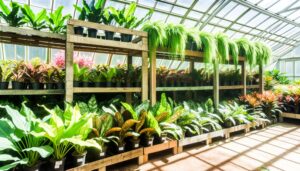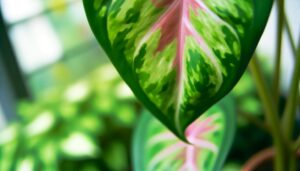What Is Philodendron Verrucosum 'Cobra'?
Philodendron Verrucosum 'Cobra' is a notable Araceae family member, characterized by velvety, heart-shaped leaves with contrasting iridescent veins. These leaves typically exhibit rich dark green hues with white or yellow veins and deep red or purple undersides.
The petioles are distinctive, covered in wart-like protrusions known as verrucae. This hemiepiphytic species, native to the tropical rainforests of Central and South America, thrives in bright, indirect light, high humidity, and consistently moist soil.
Effective propagation is achieved through stem cuttings. Regular attention to humidity and pest prevention is essential for best growth.
There are further intriguing aspects yet to uncover.
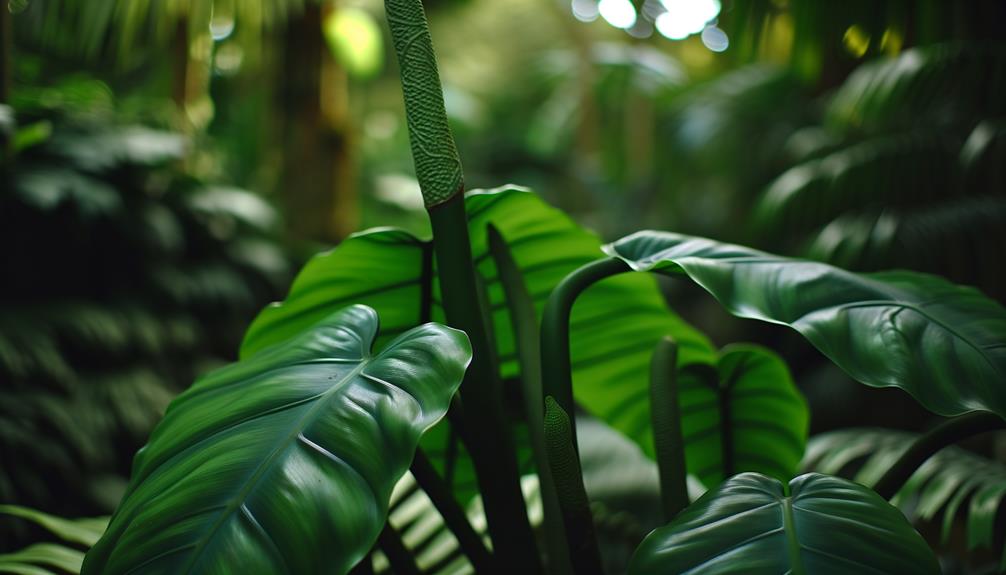
Key Takeaways
- Philodendron Verrucosum 'Cobra' features velvety, heart-shaped dark green leaves with striking white or yellow veins.
- The plant has petioles covered in verrucae, adding a unique tactile quality.
- It thrives in bright, indirect light with temperatures between 18-25°C and high humidity.
- Native to Central and South American tropical rainforests, it has a climbing habit using aerial roots.
- Common pests include spider mites, aphids, and mealybugs, while root rot and leaf spot are prevalent diseases.
Unique Characteristics
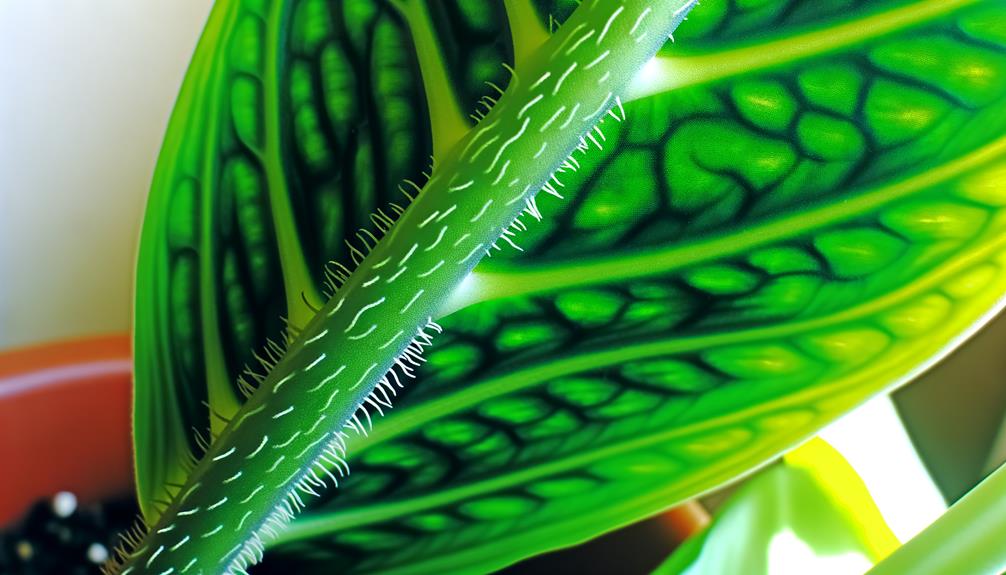
Philodendron Verrucosum 'Cobra' is distinguished by its striking, velvety leaves adorned with prominent, contrasting veins that create a visually enchanting texture. The leaves, typically heart-shaped, exhibit a rich, dark green hue with a velvety surface, accentuated by prominent, almost iridescent white or yellow veins. This variegation enhances the plant's overall aesthetic, making it highly sought after by collectors.
The petioles are often covered with small, wart-like growths, known as verrucae, which contribute to its unique tactile quality. The undersides of the leaves are tinged with a deep red or purple coloration, adding to the plant's visual appeal. Philodendron Verrucosum 'Cobra' also displays a climbing habit, using its aerial roots to anchor onto supports, thereby facilitating vertical growth.
Origin and History
Native to the tropical rainforests of Central and South America, Philodendron Verrucosum 'Cobra' thrives in the humid understory, where it has adapted to a life of climbing and attaching to trees. This species, belonging to the Araceae family, exhibits hemiepiphytic growth patterns, meaning it can start its life in the soil and later climb trees for support.
Historically, it has been documented in regions such as Ecuador, Colombia, and Costa Rica. The plant's distinct morphology, characterized by velvety leaves with pronounced vein patterns, reflects its evolutionary adaptations to low light conditions. Discovered by botanists exploring these biodiverse ecosystems, Philodendron Verrucosum 'Cobra' has since captivated horticultural enthusiasts worldwide for its striking appearance and unique climbing habits.
Ideal Growing Conditions
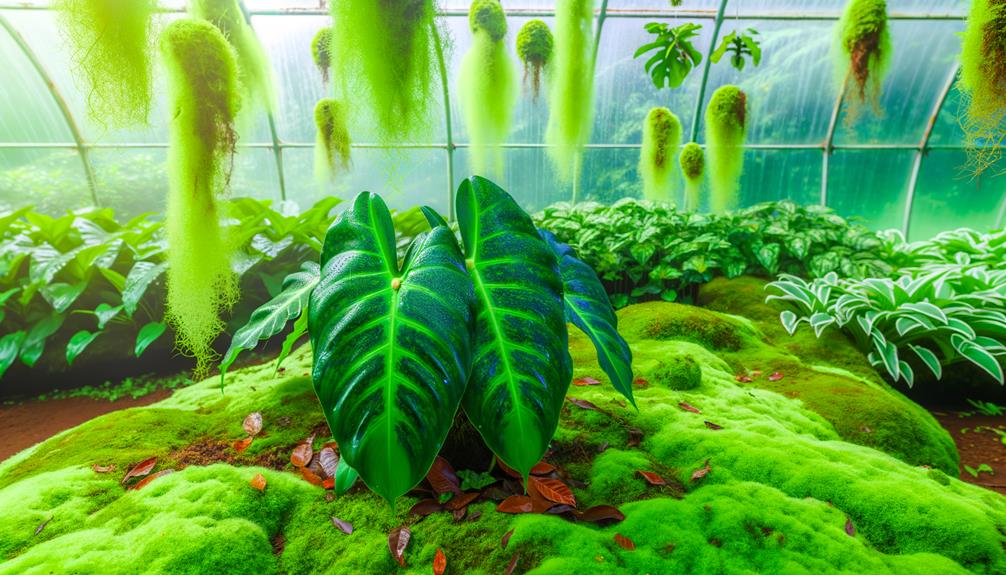
Philodendron verrucosum 'Cobra' thrives under specific environmental conditions that mimic its native tropical habitat. Best growth is achieved with bright, indirect light and temperatures ranging between 18-25°C.
Additionally, maintaining high humidity levels and consistent but moderate watering is essential for sustaining the plant's health and vibrancy.
Light and Temperature Needs
Peak growth for Philodendron verrucosum 'Cobra' necessitates bright, indirect light, coupled with temperatures consistently maintained between 65-80°F (18-27°C). Excessive direct sunlight can scorch the delicate foliage, leading to discoloration and reduced vitality. In contrast, insufficient light results in leggy growth and diminished leaf coloration.
To achieve best photosynthesis, position the plant near east or north-facing windows, where it can receive filtered sunlight.
Temperature fluctuations, particularly below 60°F (15°C), can stress the plant, impeding growth and potentially causing leaf drop. Conversely, temperatures exceeding 85°F (29°C) may lead to heat stress, marked by wilted leaves and stunted development.
Hence, maintaining a stable environment within the specified temperature range is important for the Philodendron verrucosum 'Cobra's' robust growth and health.
Watering and Humidity Requirements
Maintaining ideal watering practices and humidity levels is equally vital for the healthy growth of Philodendron verrucosum 'Cobra'. This species thrives in consistently moist but well-draining soil. Overwatering can lead to root rot, while under-watering may cause leaf desiccation. A balanced approach involves watering when the top inch of soil feels dry to the touch.
Humidity is another significant factor; Philodendron verrucosum 'Cobra' prefers environments with 60-80% relative humidity. Insufficient humidity can result in browning leaf edges and reduced vigor. Utilizing a humidity tray, misting, or a humidifier can help maintain optimal conditions.
Observing these parameters ensures robust growth and the striking, velvety foliage characteristic of this tropical species.
Watering and Humidity
Best watering and humidity conditions are crucial for the healthy growth of Philodendron verrucosum 'Cobra', guaranteeing its vibrant foliage and overall health. This tropical plant thrives in environments that mimic its native habitat, which includes high humidity and consistent moisture.
- Watering: Sustain soil moisture by watering when the top inch feels dry. Use distilled or rainwater to avoid mineral buildup.
- Humidity: Maintain humidity levels between 60-80%. Utilizing a humidifier or placing the plant on a pebble tray with water can help maintain these levels.
- Monitoring: Regularly check the leaves for signs of overwatering, such as yellowing, and under-watering, including brown leaf edges.
Proper attention to these factors promotes robust growth and vibrant foliage.
Soil and Fertilization
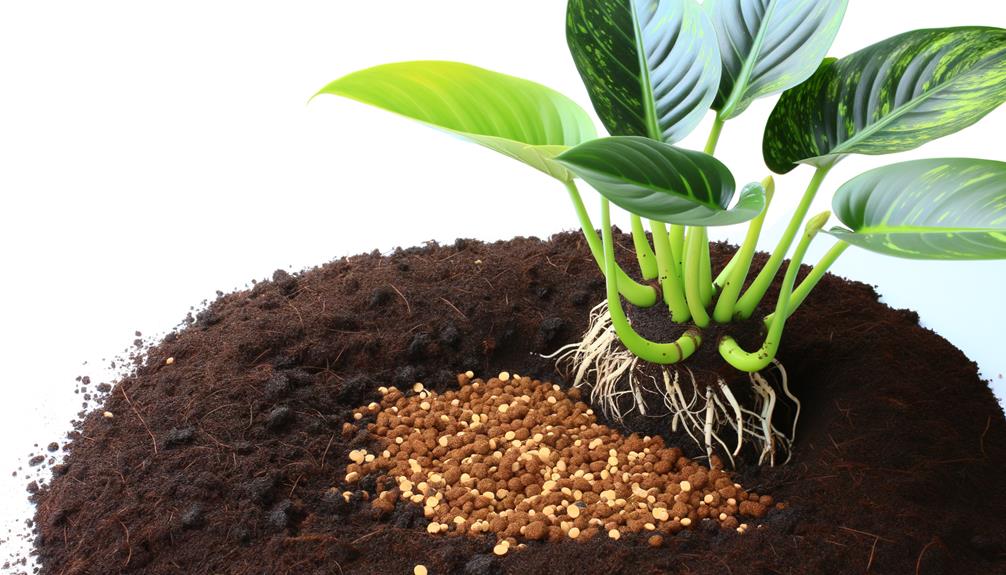
For the best growth of Philodendron verrucosum 'Cobra', a well-aerated soil mix with high organic matter is vital, ideally comprising peat, perlite, and orchid bark.
The plant benefits from a balanced fertilizer, preferably a 20-20-20 NPK formula, applied bi-monthly during the growing season.
Ensuring the soil remains consistently moist while avoiding waterlogging is essential for nutrient uptake and root health.
Optimal Soil Composition
To ensure the Philodendron verrucosum 'Cobra' thrives, a well-draining soil mixture rich in organic matter is crucial for best growth and nutrient uptake. The perfect soil composition should facilitate proper aeration and moisture retention while preventing waterlogging, which can lead to root rot.
- Peat Moss: Enhances moisture retention and provides organic content, ideal for maintaining consistent hydration levels.
- Perlite or Pumice: Promotes aeration and drainage, preventing soil compaction and ensuring roots receive sufficient oxygen.
- Compost or Aged Manure: Supplies essential organic nutrients, supporting robust growth and microbial activity within the soil.
Combining these elements creates an ideal environment for the Philodendron verrucosum 'Cobra' to flourish, ensuring healthy root development and sustained plant well-being.
Nutrient Requirements
Proper fertilization and soil amendments are crucial to meet the complex nutrient demands of Philodendron verrucosum 'Cobra', ensuring vigorous growth and vibrant foliage. This species thrives in a well-draining, nutrient-rich substrate. A balanced N-P-K (nitrogen-phosphorus-potassium) ratio is critical, along with micronutrients such as magnesium (Mg), calcium (Ca), and iron (Fe). Organic matter, such as compost or aged manure, can enhance soil fertility.
| Nutrient | Function | Source |
|---|---|---|
| Nitrogen (N) | Promotes leaf growth | Fish emulsion, blood meal |
| Phosphorus (P) | Encourages root development | Bone meal, rock phosphate |
| Potassium (K) | Enhances overall plant health | Kelp meal, wood ash |
| Magnesium (Mg) | Crucial for photosynthesis | Epsom salts, dolomite lime |
Adequate nutrient supply is crucial for the metabolic processes and structural development of P. verrucosum 'Cobra'.
Fertilizing Frequency
Determining the best fertilizing frequency for Philodendron verrucosum 'Cobra' involves understanding its growth cycle and environmental conditions. This epiphytic species, native to tropical rainforests, thrives with consistent nutrient supplementation during its active growth periods.
Observations suggest ideal fertilization practices should consider:
- Active Growth Phase: Fertilize every two weeks with a balanced, water-soluble fertilizer (e.g., 20-20-20 NPK) during spring and summer.
- Dormant Phase: Reduce fertilizing frequency to once a month during autumn and winter when growth slows down.
- Soil Composition: Utilize a well-draining, organic-rich medium that retains some moisture but allows excess water to escape, preventing root rot.
Adhering to these guidelines helps promote robust, healthy growth and vibrant foliage characteristic of P. verrucosum 'Cobra'.
Common Pests and Diseases
Philodendron verrucosum 'Cobra' is susceptible to a variety of common pests, including spider mites (Tetranychidae), aphids (Aphidoidea), and mealybugs (Pseudococcidae). These pests can cause significant damage, manifesting as discolored leaves, stunted growth, and reduced plant vigor. Regular inspection and early intervention are essential for maintaining plant health. Additionally, Philodendron verrucosum 'Cobra' is prone to fungal infections, such as root rot (Pythium spp.) and leaf spot (Cercospora spp.). Ensuring proper drainage, avoiding overhead watering, and maintaining appropriate humidity levels can mitigate these issues. Below is a detailed summary of common pests and diseases:
| Pest/Disease | Scientific Name | Symptoms |
|---|---|---|
| Spider Mites | Tetranychidae | Discolored leaves, webbing |
| Aphids | Aphidoidea | Stunted growth, sticky residue |
| Root Rot | Pythium spp. | Wilting, root discoloration |
Propagation Techniques
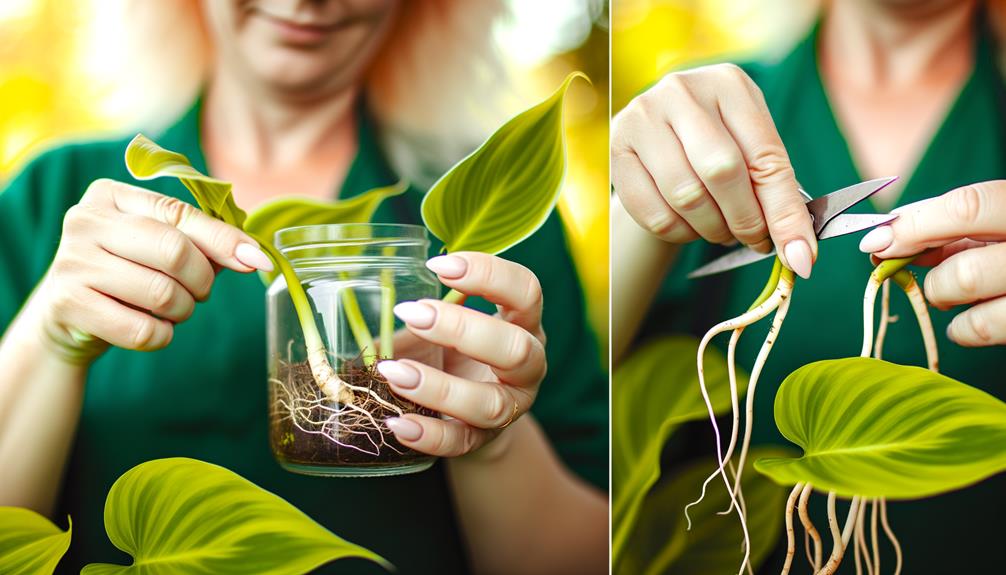
Propagation of Philodendron verrucosum 'Cobra' can be effectively achieved through stem cuttings. These cuttings should be taken from healthy, mature plants to ensure prosperous root development.
The following steps outline the propagation process:
- Selection of Cutting: Choose a stem segment with at least one node and a few healthy leaves. Verify the cutting is 4-6 inches long.
- Preparation: Remove any lower leaves to uncover the node. Optionally, dip the cut end in a rooting hormone to boost root formation.
- Planting: Place the cutting in a well-draining, sterile medium such as perlite or sphagnum moss. Maintain high humidity and consistent moisture levels around the cutting.
These steps, when executed carefully, secure the successful propagation of Philodendron verrucosum 'Cobra'.
Conclusion
Coincidentally, the Philodendron verrucosum 'Cobra' encapsulates the essence of botanical adaptation and aesthetic allure. Its unique characteristics, coupled with its specific origin and history, underscore its desirability among horticulturists.
When cultivated under ideal growing conditions, with meticulous attention to watering, humidity, soil, and fertilization, this species thrives remarkably. Despite being susceptible to common pests and diseases, effective propagation techniques ensure its continuity.
Consequently, Philodendron verrucosum 'Cobra' exemplifies the intersection of botanical science and horticultural elegance.

